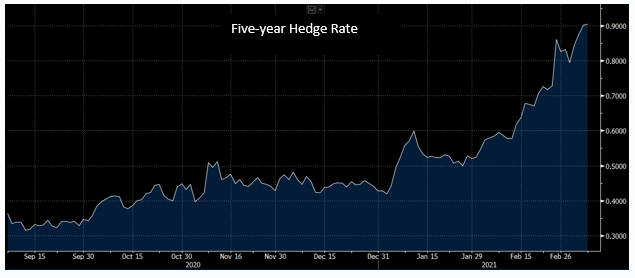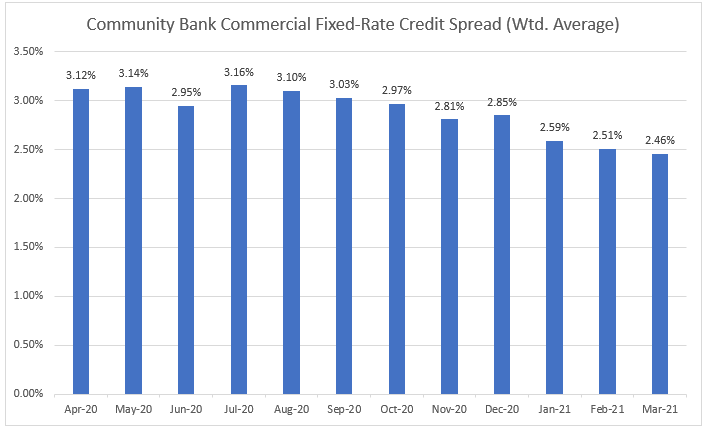The Biggest Mistakes When Pricing A Fixed Rate Commercial Loan
We estimate that approximately 80% of all banks in the country do not have a commercial loan pricing model that adjusts for credit risk, the shape of the yield curve, acquisition costs, maintenance costs, or relationship revenue. However, banks do not need a loan pricing model to eliminate the biggest mistake commonly committed today on commercial loan pricing. Community banks should not commit to a fixed rate to a borrower and instead should quote loan rates as a spread over an index.
Banks Should Adjust Pricing to Market Movement
Many community banks allow lenders to quote a loan rate and honor that rate until the loan closes. Sometimes that period can be 45 days, but we work with some banks that will honor that rate for up to two months. When interest rates are stable, this practice causes little concern. However, when interest rates move (up or down), banks subject themselves to unwanted risk.
The graph below shows the five-year hedge rate over the past 6 months and shows how interest rates have risen steadily by 59 basis points over that period. A graph showing FHLB rates, Treasury yields, or other terms structures would show a similar story.

If your bank quoted a fixed rate to a borrower good for 45 days, you would have accepted an average of 15bps lower spread than anticipated. In fact, our analysis of data for community bank commercial loans shows that fixed-rate spread has generally declined steadily over the past nine months, as shown in the graph below. The primary culprit is banks fixing the rate to the borrower weeks or months before closing while interest rates (and funding rates) continue to climb.

Game Theory Behind Fixing a Loan Rate
Some bankers will argue that over the long term, with rates moving up and down, the bank would offset some loans that are made above market rates with some loans that are made below-market rates. However, our analysis shows that the lender is almost always at a disadvantage fixing the loan rate before closing.
Consider that generally, there are four possible scenarios to fixing a rate before the loan closing. Rates can go up or down, and the borrower may choose to close or not close the loan. The table below describes the four possible scenarios of rates rising or falling and the borrower accepting or rejecting the loan. By not adjusting pricing to reflect market-driven interest rate movement, a bank can only create value (or be in a positive outcome) if a borrower is not aware of interest rate movement or is price insensitive. While this scenario may occur some of the time, we believe that it cannot occur frequently enough for banks to build a business model and sustain a loan portfolio.

The outcomes are even worse for banks in a steadily rising interest rate environment, where rates are rebounding from historically low levels – as is currently the case. We must remember that in the vast majority of the cases, the borrower holds the ultimate option of accepting the loan or rejecting it. In fact, the situation is even worse because borrowers tend to prolong the closing process when they are given a fixed loan rate as the borrower has no incentive to expedite the closing.
Solution
Bankers must be vigilant to adjust all pricing quotes to borrowers over an index – whether that index is Prime, Treasuries, or hedge rates. Even if a banker wants to earn a fixed rate that may not be quoted as a spread to an index, the fixed-rate must nonetheless be internally generated by adding a spread to an appropriate index.
Of course, the ultimate erosion of spread may not occur over the 45 days of interest rate movement leading to the closing, but over the next few years, while the fixed-rate loan is on the bank’s balance sheet and funding costs move in unexpected ways.

